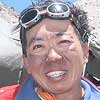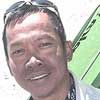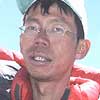The team shares their thoughts on the expedition, now that they are back and the laundry’s done…
 David Lim, Leader
David Lim, Leader
The Expedition team is back safely in Singapore. Most will be heading back to work next week after sorting out about 40 kilos of laundry, expedition kit and gear per person. Tech Officer Wong Ting Sern’s house is home to about 30 expedition barrels not to mention communications gear. We have hours of video footage to look at, with possibilities of a documentary and many slides to sort out for a public slide show at some point.
The two most often asked questions I get personally are:
1) Are you enjoying the local food again ? and
2) Are you going back?
Both are easy enough to answer
1) Yes, but in moderation! We have to get our digestive systems back in synch with local food and not overdo it . As it is we’ve already tucked into our local favourites like char kway teow, grilled fish in soy sauce, and most recently, a great ‘ welcome home’ BBQ dinner hosted by His Excellency Paolo Pinheiro, Ambassador of Brazil
2) Probably not in the near future. Everest demands an immense investment in time, risk management and opportunity cost. None of the team are paid to climb and it took over a year to raise the funds, coordinate the various awareness-building and community activities. For Rozani, Gil and myself for example, we were effective unemployed for three months with no income.
For all of us, I think it would be nice to be able to summit but Everest is one of those kind of mountains which will grant you the privilege of summitting her snowy top under perfect conditions. In this respect I mean you need a great day to climb to the top or a series of good days prior to that to get into position as well. You need a strong team to support the climb. Your health needs to be good as does your acclimatisation. Even then, as our American friends on the IMG 8000 expedition discovered, curve balls can come your way and you may be faced with a moral decision to get (or not) involved in a rescue en route to the top. A 101 things can conspire to thwart your goal.
So, as we began this expedition, the view that still prevails in the team: summitting would always be a bonus but not the only or the most important goal.
Our website http://www.everest.org.sg garnered almost 1 million hits with monthly average in March – May of nearly 300,000 hits. Well wishers and kind words were sent from all over the world.
I’d like to end by making an appeal for the Society for the Physically Disabled, Brands Essence of Chicken’s website are offering to donate a
small sum for every online registration of support received on http://www.brandsworld.com.sg – Brands will be wrapping up the “click and register” appeal very soon.
I think this is an excellent contribution by them at no cost to interested readers/surfers except for a few minutes of their time. All proceeds to go the Society. Both Wong Ting Sern and I went to Everest with our own physical disabilities and these proved to be challenging to overcome. Many less fortunate here in Singapore may never leave a wheelchair or walk without a crutch. Do publicise this website and the appeal.
Many thanks and regards,
David Lim
Leader,
Singapore Latin American Everest Expedition 2001
 Mohd Rozani bin Maarof
Mohd Rozani bin Maarof
The north-side of Everest was the most beautiul climb I’ve ever come across in my entire climbing life. The history and the route we took to climb on it makes it more appealing for a climber like me to be there.
Even though we did not make it to the top, the experience was worth it. I have learnt a lot… about the mountain, the weather, coping with altitude (health), alot more about people, and myself.
After almost 3 months with Gil, I also got to know more about Brazil. It is certainly more than just Pele or Senna. There is that green stuff that Gil drinks, mate… It’s a cultural exchange between us, Singaporeans and one Brazilian.
We also found out that we can survive at an altitude of 7,800m without bottled oxygen. Hopefully the next generation of climbers from Singapore would stretch the limits without bottled oxygen, maybe above 8000 meters.
Now that we are back home we have a lot of catching up to do… and lots of good food to
eat.
Personally, I would like to thank to all our sponsors, supporters and well-wishers for making this climb the most memorable one. Till the next climb. Over and out.
Mohd Rozani.
 Tok Beng Cheong, Deputy Leader
Tok Beng Cheong, Deputy Leader
Time passed in a blink of an eye. Before we even realised it, our 75 day Everest expedition was over! All the team members are now catching up with their favourite food, family, friends and loved ones. We are back to civilisation, work and normal life.
Taking a moment to look back and reflect upon our accomplishments ……… we have gone through an enormous amount of preparation, training trips, fund raisings and other events; all of which were either directly or indirectly related to this entire Everest endeavour. Although we have finished our journey on Everest, we will continue to use what we have learned as a basis for building confidence and life experiences as we accept future challenges…
Personally, and as a team, we felt we were successful. We all attained our personal best and we gave it our best shot. We all lived …… we all learned – individually and collectively.
This entire Everest endeavour would not have been possible without the kind support of our sponsors. We also thank our families, employers, friends and loved ones for their encouragement.
We would like to convey our special thanks to His Excellency, President SR Nathan, for having the believe and trust in taking the bold step of being the expedition patron. We also thank His Excellency, Mr. Paulo Pinheiro, the Ambassador of Brazil, for gracing our expedition launch, sending-off ceremony, and a wonderful ‘welcome back barbecue’ dinner at his residence upon our return
Tok Beng Cheong
Deputy Leader,
Singapore Latin American Everest Expedition 2001
 Wong Ting Sern, Base Camp Support & Technical Officer
Wong Ting Sern, Base Camp Support & Technical Officer
This expedition has been an eye opener for me. Since this is first time I was involved in a major mountaineering expedition, I certainly learnt a lot of things.
I didn’t realise how much effort is required to raise funds for such an expedition until I was involved in it – and even then, my role there was marginal. In fact, the amount of work needed for fund raising was far greater than the work needed to climb the mountain !!!
However ……….
I had a great time developing, and testing the solar power generating equipment. Building the “black boxes” that converted 12V DC to 15V-25V DC variable at 5amps and greater was an achievement – because nobody in Singapore sells such an equipment and everybody I asked said – it couldn’t be done. It was the best piece of hardware I carried up there – because it enabled me to charge at least 2 pieces of equipment simultaneously. It was also very hardy (after all, it was “over-engineered” for reliability) in the extreme weather up at base camp.
Testing and integrating the two diverse satellite communications equipment (Ericsson R190 and Nera Mini-M) was the next biggest challenge. However, I now realised that no amount of testing in Singapore can simulate the weather conditions up at Everest base camp. Some of the problems I saw up there was unique to that environment only. Anyway, getting the Apple Powerbook to talk to both satcoms equipment was a big challenge for me at that time – because I was not confident in getting them to talk initially. But, after an initial round of testing and connections, I began to gain confidence that I could make the whole thing work. While problems due to atmospheric conditions at base camp did crop up again and again, over all, I did manage to maintain satellite links satisfactorily.
However, my biggest challenge was to connect the Nera World Communicator (an ISDN device) to the Apple Powerbook in the field – something that even Nera has washed their hands off. I wanted to make the Apple Powerbook talk to the World Communicator because it is a much faster device (64K bits/sec versus 2400 bits/sec for the Ericsson R190 and Nera Mini-M), and also because the airtime was sponsored by Temasek Polytechnic, success would mean some cost savings for the expedition as well. We could send emails and large files from the Powerbook instead of transferring the files from Powerbook to the IBM PC. Well, I did make the Apple talk to the World Communicator after about 4 hours of work at base camp – and that achievement brings me great satisfaction.
Then, I had to learn a new OS and a new platform – the Apple’s OS and hardware. Not just the user level interface, but the deeper OS internals and learn to service the Apple Powerbook in the field. It was a big challenge because of the extreme shortage of time here.
If I am offered another chance to do this again, I would jump on it. But, then the learning curve will not be that steep anymore and maybe, “less fun” than this first timer.
Ting Sern
 Gil Francisco Piekarz
Gil Francisco Piekarz
O momento de parar.
A nossa expedição ao Everest consumiu um planejamento de mais de um ano, esforços para conseguir o patrocínio (que no caso eu não consegui aqui no Brasil, salvo o apoio das passagens aéreas fornecidas pela Snake) necessário para cobrir os gastos da expedição que beiraram os US$200.000,00 (duzentos mil dólares); gerenciar uma licença de 3 meses no emprego, e ficar sem o salário nestes 3 meses, ficar dois meses acima dos 5.400m de altitude, num clima e em condições onde a vida humana não é possível, perder mais de 10 kg em peso; comer e beber por pura obrigação, sem prazer; ficar dias dentro da barraca, pois fora dela o clima não pemitia, e quando saia era para fazer longas jornadas para altitudes onde o vento, a temperatura e a falta de oxigênio eram quase insuportáveis. Tudo isto para chegar a um único ponto, ficar poucos minutos e voltar o mais rápido possível, sabendo de antemão que muitos morrem na volta, outros não conseguem chegar a tempo nas barracas antes que a noite caia e ficam com fortes sequelas (congelamentos); isto quando conseguem sobreviver.
Então, porque tentamos escalar estas grandes montanhas? muitos devem se perguntar, e aqueles que não são do “meio” realmente não conseguem entender, o que é lógico. Para mim a escalada da alta montanha não é apenas um esporte em si, mas também um “hobby” e principalmente um JOGO. Um jogo pessoal, de eu junto a mim e contra mim. A montanha é apenas o campo para jogar, e o cume a taça pessoal. Como muitos devem imaginar, erroneamente na minha interpretação, sair do jogo é extremamente fácil, pois um dos jogadores adversários é o fator psicológico do questionamento do “o que eu estou fazendo aqui”, porém, desistir de continuar jogando é frustante, é desperdiçar e jogar fora com enorme prejuízo pessoal, todas aquelas dificuldades vencidas e citadas no início. A não ser que o motivo da desistência esteja muito acima do cume da montanha. E foi o que nos aconteceu. A chance de chegarmos ao cume do Everest era enorme, pois havíamos vencido duas, das três grandes dificuldades de escalar o Everest pelo Tibet, e a nossa estrutura para a terceira grande dificuldade, a etapa final de ataque ao cume, era perfeita – com oxigênio artificial praticamente à vontade e uma equipe de Sherpas para nos ajudar. Voltamos porquê um membro da equipe estava em dificuldades e nós éramos um time, além de, principalmente, amigos. No momento a sensação foi aquela que eu descrevi, de alívio; o corpo e a mente agradeciam, ao mesmo tempo em que fiquei triste em ter que sair do jogo, porém nunca frustado.
E quem são os jogadores que participam? se sou eu comigo e contra mim? e a montanha apenas o campo?
A favor estão: o preparo físico e psicológico prévio, o mesmo dos companheiros, a organização prévia, a estrutura montada, os cuidados e facilidades com a alimentação e hidratação, os equipamentos adequados, disponibilidade de oxigênio e de Sherpas para ajudar, o ambiente motivacional e de respeito entre os membros do time, ser um time, e a vontade suprema de chegar até o limite com segurança.
O Everest foi o campo, com suas armadilhas, como o ar rarefeito, o frio, o vento, as dificuldades técnicas, avalanches.
Os adversários: eles estão dentro de nós mesmos. A montanha nunca é o adversário. Além do clima, os principais adversários são as condições impostas pelo ambiente ao nosso corpo e mente. Quando subimos para altitudes cada vez maiores necessitamos de um aporte maior de calorias, porém não conseguimos nos alimentar de modo adequado. Náuseas e inapetências aos alimentos ocorrem e começa-se a forçar a alimentação – eu amagreci 10 kg após 2 meses nas altitudes; também a diminuição drástica da pressão obriga o coração a trabalhar muito mais, ocorre a hiperventilação com uma perda enorme de líquidos e quanto maior a altitude, mais seco é o ar. É necessário beber mais, e como com a comida, beber é difícil, não é um prazer e sim mais um “trabalho”; é o ambiente obrigando o nosso corpo a descer.
No entanto, o adversário mais poderoso não são estas reações fisiológicas mas sim a mente. Ela começa a nos desestimular a continuar subindo, pois estamos indo para altitudes onde a vida não é possível e ela sabe disso, tenta nos salvar. Os primeiros sintomas é que a escalada começa a perder o sentido e o pensamento do “o que é que estou fazendo aqui” começa a ficar cada vez mais forte. Alguma parte de nós resiste e então ela inicia um processo ainda mais duro e selvagem. Saudades e sentimento de culpa começam a aflorar. Saudades de tudo que temos aqui, família, amigos, lugares. O medo de não voltar e de não ver mais as pessoas e as coisas queridas; o sentimento de culpa por estarmos ali por nossa própria vontade e de nos expormos ao perigo de não participarmos mais da vida aqui na Terra. Realmente é um jogo fascinante, e terrível ao mesmo tempo. Àqueles que querem se aventurar por estes meios é fundamental a consciência destes fatores e, sobretudo, saberem o momento de parar, por sua vida ou pela vida de um companheiro.
Agora, aqui sentado em frente ao computador, em temperaturas agradáveis e com muito oxigênio para respirar, seria uma grande hipocrisia de minha parte dizer que estou frustado por não ter chegado ao cume do Everest. Obviamente eu estava lá para isto. Porém o gigantismo do Everest não permite, de modo sincero, este tipo de sentimento. O fato de ter estado em suas encostas por mais de 2 meses, com um verdadeiro time, foi para mim uma experiência extraordinária. Chegar ao cume, ao topo da montanha que nos propomos a chegar é muito bom e muito importante. No entanto, isto não é o mais importante, o mais importante é tentar, sempre tentar, é participar do jogo, e nunca, mas nunca mesmo desistir daquilo que se propõe.
Gil.
Leave a Reply